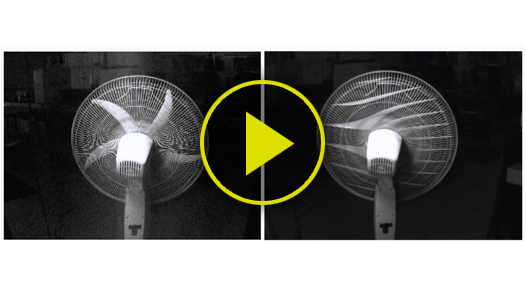 So what’s the difference between global and rolling shutters?
So what’s the difference between global and rolling shutters?
The difference is between how CCD and CMOS sensors capture and process pixels. A CCD sensor usually has a global shutter and a CMOS sensor usually has a rolling shutter. Above is a video comparison of a fan at normal speed with a global and rolling shutter – we used a DMK-23U274 (CCD) and DMK-72BUC02 (CMOS) monochrome digital camera to capture the footage.
Rolling Shutter – CMOS
CMOS stands for Complementary Metal Oxide Semiconductor and is also referred to as an APS (Active Pixel Sensor) in the consumer market. CMOS or APS sensors read all of their pixels linearly from top left to bottom right while the shutter is open. The pixels don’t store any charge, they simply read how much light is hitting that pixel at the exact moment and convert that into an electrical signal. A rolling shutter (as opposed to a global shutter) is always active and “rolling” through pixels from top to bottom. This can result in the now-familiar motion artifacts often referred to as “jello.”
Global Shutter – CCD
CCD stands for Charge Coupled Device, and unlike the APS sensors, the pixels in a CCD store their charge until it has been depleted. A camera that has a CCD sensor almost always also has a shutter system, which can be electronic or mechanical. The CCD captures the entire image at the same time and then reads the information after the capture is completed, rather than reading top to bottom during the exposure. Because it captures everything at once, the shutter is considered “global”. The result is an image with no motion artifacts.
– Joe Rubinstein, www.digitalbolex.com
Application
Although CCDs are not the only technology to allow for light detection, CCD image sensors are widely used in professional, medical, and scientific applications where high-quality image data is required. In applications where a somewhat lower quality can be tolerated, such as webcams, cheaper active pixel sensors (CMOS) are generally used.
-Wikipedia.org
Contact Us
View our line of USB 3.0 Monochrome Cameras here.
View our line of USB 2.0 Monochrome Cameras here.
For more information – send us an email at [email protected], call us at 1-888-919-2263, or leave us a comment below.
